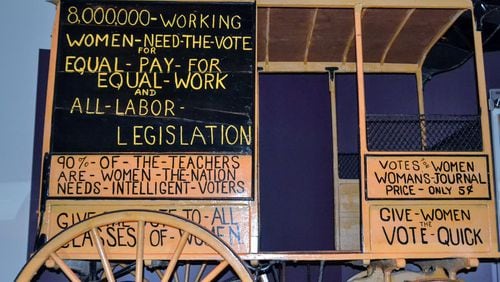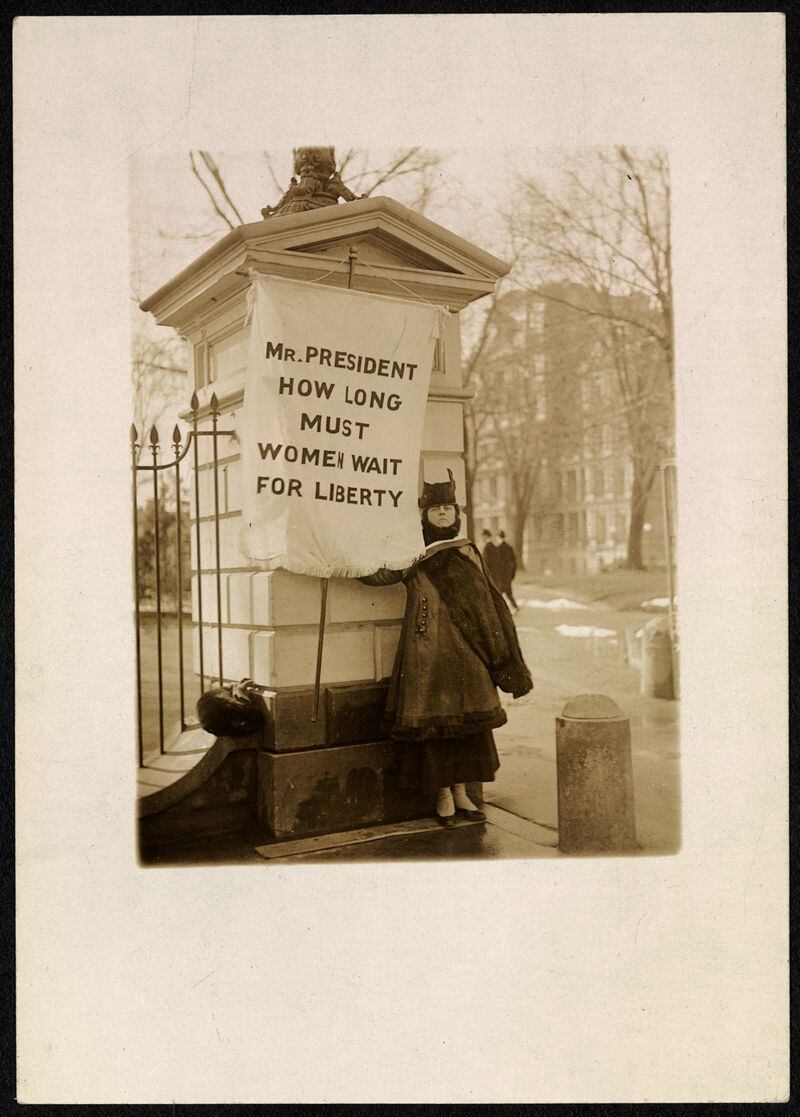LORTON, Va. — The windows in Martin Cervantez’s towering artworks never look the same, their gentle colors changing subtly with the arc of the sun.
They also never look like what they once were: tower windows from which guards watched inmates at the notorious Lorton Reformatory.
Those windows are emblematic of the change from correction facility to a haven for artists called the Workhouse Arts Center, created from the bones of the onetime reformatory in southern Fairfax County, outside the nation’s capital.
The beauty of the artworks made here and the energy that accompanies their creation are a surprise in a place where ugly events once were the norm, including one so horrifying it was called the Night of Terror.
Not ringing a bell? Not surprising. But what happened here on Nov. 14, 1917 — it was called the Occoquan Workhouse then — changed U.S. history.
Teddy Roosevelt could never have imagined that the workhouse he had created in 1910 to help minor criminals develop useful skills would become the pivot point in the struggle to pass the 19th Amendment, which gave American women the right to vote.
Credit: Handout
Credit: Handout
The struggle took 72 years, the efforts of hundreds of thousands of people, and unfathomable violence at Occoquan directed at champions of the cause who did nothing more than quietly picket the White House.
In answer to the banners these advocates carried that asked, “Mr. President, what will you do for woman suffrage?” they were arrested, detained, beaten, kicked, choked, stripped naked, chained to the bars in a workhouse cell, stabbed with a stick that once carried a protest banner and force-fed until they became ill.
The unusual and intriguing art created here today could almost make you forget what happened on these grounds.
But not quite.
———
SILENT SENTINELS
Before any discussion about the history of the right to vote, note that the U.S. women who fought for it are called suffragists, not suffragettes.
It is a distinction with a difference: In Britain, suffragettes, as they were called there, used more radical means to attract attention to the cause, including property damage and demonstrations.
But Alice Paul, a Quaker from New Jersey, believed that peaceful methods would win the day. That is why Paul, founder of the National Woman’s Party; Lucy Burns, her right hand; and dozens of others picketed the White House using words as their weapons.
Their strategy: Embarrass President Woodrow Wilson into paying attention, not just giving lip service, to their cause.
The Silent Sentinels, who often wore purple, gold and white sashes, the colors of the National Woman’s Party, began carrying banners as 1917 unfurled. Those words stung Wilson, who was preoccupied with World War I.
“Kaiser Wilson,” one banner said, “have you forgotten your sympathy with the poor Germans because they were not self-governed? 20,000,000 American women are not self-governed. Take the beam out of your own eye.”
The arrests of the picketers began a couple of months after the U.S. entered the war that April. They were charged with obstructing traffic, absurd given that they were standing on the sidewalk outside the presidential home.
On Nov. 13, more than 30 Sentinels were arrested around the White House, and by 5 p.m. the next day, many were on their way to the Occoquan Workhouse. (Paul remained in a District of Columbia jail, presumably because her opponents wanted to separate the head from what they perceived as the snake.)
Four hours later, Occoquan Superintendent W.H. Whittaker set his guards upon the women. Dora Lewis, thrown into a cell, hit her head on an iron bed. Cellmate Alice Cosu thought Lewis was dead (she survived) and suffered a heart attack.
Lucy Burns was stripped naked, her hands raised over her head and chained to the bars until the next day.
Some of the women protested the physical abuse of that one night by going on a hunger strike. For their troubles, they were force-fed raw eggs and milk, which made them violently ill.
Those who did not fast were given food so horrific, part of the psychological cat-and-mouse game, that they sent worms found in their soup and bread to the warden.
Lawyers for the women said that because they had been sentenced in the District of Columbia, it was illegal to place them in the Virginia workhouse.
A Virginia judge agreed, and they were returned to D.C. after their Nov. 23 trial. By month’s end, all had been released, weakened and, in some cases, permanently worse for the wear.
By early January 1918, Wilson expressed his support for the voting rights amendment, which passed the House but failed in the Senate. Some opponents argued that women already had the right to vote in some states, but proponents wanted an amendment to ensure that women had the right in every state.
On June 4, 1919, the Senate passed the amendment, which the House had passed two weeks earlier.
Tennessee became the 36th state to ratify the amendment on Aug. 18, 1920. Eight days later, it became part of the U.S. Constitution, more than seven decades after the first women’s rights convention in Seneca Falls, N.Y.
———
HONORING THE SUFFRAGISTS
Occoquan Workhouse had its own happy ending after years of turmoil as Lorton Reformatory, a badly run, crowded and occasionally corrupt prison. It was closed in 2001 and sold to Fairfax County.
The cells where the women were brutalized are long gone, but the remaining structures, made of bricks manufactured by the prisoners, are being or have been rehabbed, creating a handsome quadrangle of buildings where artists work, art education classes are given and, in a small museum, history is recounted.
The workhouse center has 65 artists in residence and 25 more who exhibit here. Halls are filled with handcrafted artworks as diverse as the people who make them. Many of the artists’ works, which also include photography, painting, textiles, jewelry and glass, are for sale.
On a recent Sunday afternoon, Cheryl VanderMolen Neway was finishing new batik pieces that would become hats, dresses and skirts. Hanging from the ceiling were eight purple, gold and white silk scarfs — the colors of the National Woman’s Party.
“I wanted to honor the suffragists in prison here 100 years ago,” she said. “They fought for our right to vote … and I wanted to thank them because they worked very hard to get us where we are today.”
The exuberant colors used in her pieces “put some healing energy” into the grounds of the onetime reformatory.
“I wanted to create some light where there was once darkness,” she said.
———
LUCY BURNS MUSEUM
The Workhouse Arts Center is a work in progress; the restoration of a 350-seat theater and the addition of a restaurant may be in the offing.
Perhaps most important, the Lucy Burns Museum, honoring not only that suffragist leader but also those who gave their all to get the vote, is expected to be completed later this year.
If you visit the center, it’s because you’ve been drawn here by the art and by classes, festivals and even weddings. It is off the beaten path, said Ava Spece, president and chief executive of the Workhouse Arts Foundation, which manages the center. If you’re here, it’s because you want to be, she said.
A study of the handsome brick buildings, a listen to the murmur of artists at work, a look at the beauty of the objects they create, raises this question: Who would not want to be here, on a campus cloaked in important history that’s almost been obscured by time?
It’s like having the keys to a secret history book that tells a story whose moral is about perseverance.
At the entrance to the campus, a bronze sculpture, “An Hour Before Dawn,” on loan from artist Sassona Norton, faces where the buildings that housed the female prisoners once stood.
“I sculpt the figure to express yearning,” its plaque says. “While yearning may be rooted in conflict and dissatisfaction, it also points … to our ability to rise above insurmountable obstacles and cross over boundaries to realize our dreams.”
THE PATH TO NO. 19
• Workhouse Arts Center, 9518 Workhouse Way, Lorton, Va.; (703) 584-2900, www.workhousearts.org. Galleries and the visitor center are open 11 a.m.-6 p.m. Wednesdays through Saturdays and noon to 5 p.m. Sundays. A small museum devotes part of its space to suffragist history and the rest of the history of Lorton's penal system. It is open noon-3 p.m. Wednesdays through Saturdays and noon-4 p.m. Sundays. The center is building a Lucy Burns Museum not only to honor the suffragist who was jailed and brutalized here, but also to highlight the work that led to the 19th Amendment giving women the right to vote.
• National Museum of American History, 1400 Constitution Ave. N.W., Washington, D.C.; (202) 633-1000, www.americanhistory.si.edu. "The Nation We Build Together" exhibit devotes some space to voting, including suffragist history. Among the artifacts is a suffrage wagon used at rallies and speeches between the 1870s and 1920.
• Belmont-Paul Women's Equality National Monument House, 144 Constitution Ave. N.E., Washington, D.C.; (202) 543-2240, www.nps.gov/bepa. Open 9 a.m.-5 p.m. Wednesdays-Sundays; guided tours at 9:30 and 11 a.m. and 2 and 3:30 p.m.
This is the home of the National Woman’s Party, founded in 1916 by Alice Paul, the godmother of the push for the 19th Amendment. On the hourlong tours you’ll see exhibits that tell the story of the National Woman’s Party, especially focusing on the fight for passage of the amendment.
About the Author







